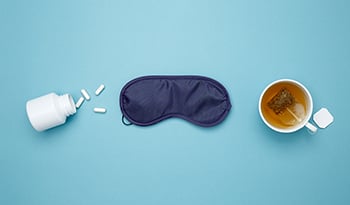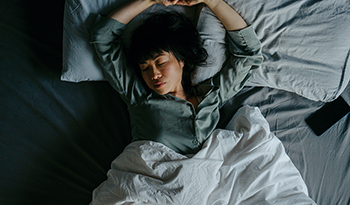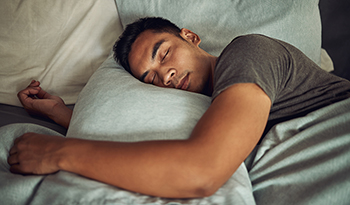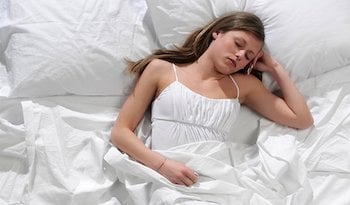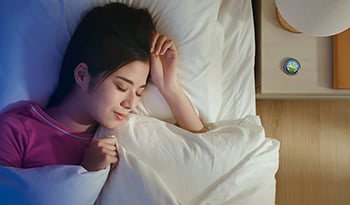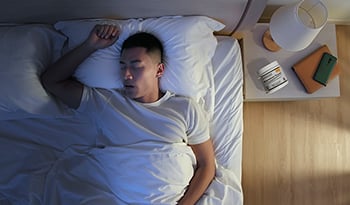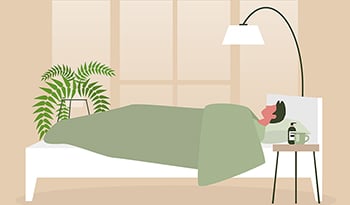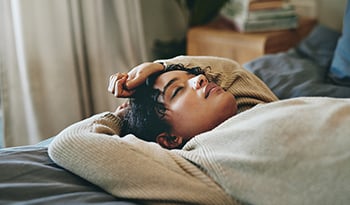Мелатонинът - не само за сън
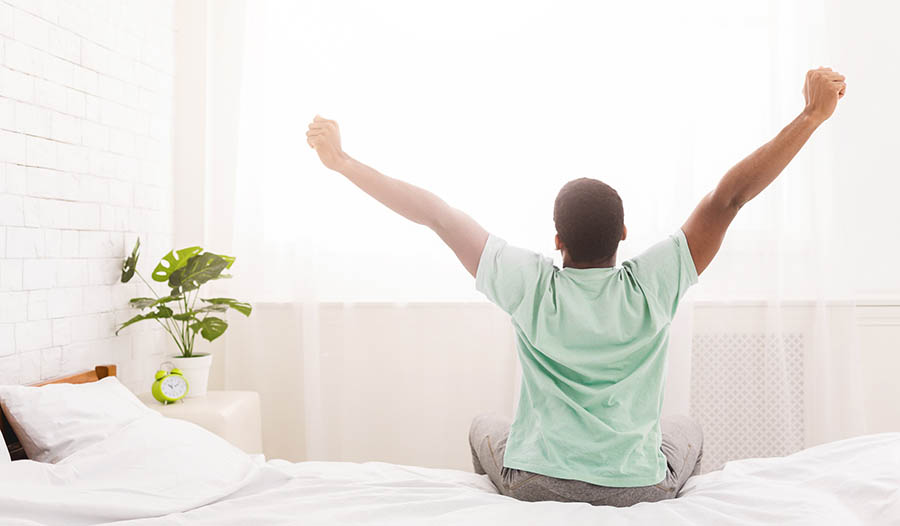
Неврохормонът Мелатонинът е най-известен като нежно, естествено средство за подпомагане на съня. За разлика от много сънотворни, отпускани с рецепта, мелатонинът не предизвиква пристрастяване и не причинява симптоми на отнемане. Предлага се в две форми - с краткотрайно и с дълготрайно действие. Краткодействащият мелатонин ни помага да заспим, а дългодействащият ни помага да останем заспали. В зависимост от модела на безсъние може да изберете краткотрайно или дълготрайно действие или комбинация от двете. Мелатонинът е и силен антиоксидант . (Ramis et al. 2015). Освен това той помага за регулирането на енергийния метаболизъм (Cipolla-Neto et al. 2014) и имунната функция (Calvo et al. 2013).
Мелатонинът се произвежда от епифизната жлеза. Супрахиазматичното ядро в хипоталамуса, малка светлочувствителна структура, регулира мелатонина. Дневната светлина потиска супрахиазматичните ядра и производството на мелатонин. Тъмнината позволява на супрахиазматичното ядро да сигнализира на епифизата да увеличи отделянето на мелатонин, който регулира нашите циркадни ритми, включително времето, когато вероятно ще заспим през нощта, и времето, когато вероятно ще се събудим сутрин. Всяка година с промяната на продължителността на светлата част от денонощието епифизната жлеза освобождава мелатонин, като регулира биоритмите ни в съответствие със сезонните промени. Една от причините за безсъние е, че някои хора по-трудно приспособяват цикъла си на сън и бодърстване към сезонните промени в околната светлина. Вследствие на това те развиват безсъние, проблеми със съня. При други може да се наблюдава намаляване на производството на мелатонин, например с напредването на възрастта. Можем да нарушим циркадните си ритми, като прекосяваме твърде много часови зони, оставаме да спим твърде късно през нощта, работим нощни смени, спим твърде късно сутрин или подремваме през деня (Brown and Gerbarg 2009).
При леко безсъние може да са необходими само 1 или 2 mg мелатонин. При умерено безсъние 3 до 6 mg са средна доза за повечето възрастни. Тежкото безсъние може да изисква до 9 или 10 mg мелатонин. Мелатонинът може да се използва безопасно в комбинация с лекарства за сън (напр. седативни хипнотици, бензодиазепини), антидепресанти и антипсихотици. За по-добър сън, независимо дали използвате мелатонин, билки или лекарства по лекарско предписание, хигиената на съня е от съществено значение. Хигиената на съня включва определяне на редовно време за лягане, избягване на стимулиращи дейности в часа преди сън (тревожни телевизионни предавания, видеоигри, работа с клавиатура), установяване на режим за лягане, ставане по едно и също време всяка сутрин, избягване на дневни дрямки и неприемане на стимулиращи храни (шоколад) или напитки (кафе с кофеин или чай) в късния следобед или вечер.
Ето някои по-малко известни ползи от мелатонина.
Мелатонинът може да помогне за намаляване на Jet lag
Много хора изпитват затруднения да регулират цикъла си на сън и бодърстване, когато пътуват в две или повече часови зони. Да заспите в 18:00 ч., защото часовникът на тялото ви усеща, че е полунощ, или да спите до обяд, защото тялото ви усеща, че е 6:00 ч., може да развали първите няколко дни от европейската ваканция. А ако пътувате по работа, джет лагът може да намали ефективността ви. Ако сте предразположени към джетлаг, може да се възползвате от комбинацията от 3 до 6 mg мелатонин , започвайки от първата нощ, когато пристигнете на местоназначението си, и 150 до 300 mg Rhodiola Rosea в момента, в който трябва да се събудите сутрин.
Мелатонин и REM поведенческо разстройство – Неспокойни нощи
Разстройството на поведението в състояние REM (RBD) обикновено се развива след 70-годишна възраст, въпреки че може да се появи по-рано или при хора, които са претърпели мозъчна травма. То се характеризира с блъскане, ритане и дори удряне по време на сън. Понякога с напредването на възрастта невронните вериги, които трябва да ни предпазват от физическо осъществяване на мечтите ни, се нарушават. Когато инхибирането на движенията се изгуби, движенията могат да пробият по време на сън. Излишно е да споменаваме, че това се отразява негативно на партньора в леглото и може да стане опасно. Например ако 80-годишен мъж по невнимание бутне 78-годишната си съпруга от леглото, тя може да получи сътресение на мозъка или счупване на кост. За съжаление диагнозата РБД често се пропуска и съпругът е обречен да спи сам на дивана. Диагнозата може да бъде потвърдена чрез изследване на съня. Обикновено РБД се лекува с бензодиазепина клоназепам, но този клас лекарства е проблематичен, особено при възрастните хора, тъй като може да увеличи риска от падане, умствено объркване, дезориентация и привикване или пристрастяване. В сравнение с клоназепама, мелатонинът има по-малко нежелани ефекти и може да бъде доста полезен за лечението на РБД (McGrane et al. 2015). В много случаи мелатонинът е ефективен за овладяване на симптомите на РБД, но може да се наложи постепенно увеличаване на дозата до 10 mg преди лягане. Най-добре е да приемате мелатонин около един до два часа преди желаното време за сън.
Мелатонин и заспиване
‘Sundowning’ е термин, който се използва за описание на това, което може да се случи на възрастните хора, когато слънцето залезе, особено когато те са в непозната среда, като болница или заведение за грижи за възрастни хора. Когато осветлението е слабо, възрастните хора се ориентират по-трудно с помощта на визуални сигнали. Тъй като са дезориентирани и объркани, те могат да се заблудят, да се изгубят или да пострадат. Обикновено използваните лекарства за сън, като Ambien или бензодиазепини, могат да засилят объркването или да причинят нарушаване на равновесието, падане, сънливост през деня, привикване или други проблеми. По-безопасно и често ефективно е да се започне с ниска доза мелатонин, например 1 mg, и да се увеличава постепенно до спиране на ‘залязването на слънцето’, но не повече от 10 mg през нощта.
Мелатонинът може да помогне при проблеми със съня от антидепресанти
При някои хора се появяват трудности със съня, когато им се дават определени лекарства, например антидепресанти от типа на инхибиторите на обратното захващане на серотонина (ИОС). Мелатонинът може да противодейства на този страничен ефект на антидепресантите, отпускани с рецепта, и по този начин да възстанови съня.
Мелатонин, здраве на ретината и добро зрение
Предварителни проучвания показват, че мелатонинът може да подобри здравето на ретината и да предотврати или забави влошаването на състоянието ѝ (Crook et al 2017). Проблемите с ретината, особено дегенерацията на макулата, често се появяват с напредването на възрастта. Прекомерното излагане на слънчева светлина предизвиква изблици на свободни радикали, които могат да причинят кумулативно увреждане на деликатните клетки на макулата - централната част на ретината, от която излиза зрителният нерв. Носенето на очила за защита от ултравиолетовите лъчи винаги, когато сме навън в слънчев ден, е най-добрата защита. За съжаление много от нас научават за този проблем едва в напреднала възраст, след като щетите вече са нанесени. Необходими са допълнителни изследвания, за да се прецени доколко мелатонинът може да предотврати, забави или възстанови дегенерацията на макулата и други проблеми на ретината.
Мелатонинът и когнитивната функция
Мелатонинът предпазва мозъчните клетки, невроните, от увреждане от свободните радикали. Смята се, че това е ключов механизъм, чрез който мелатонинът може да подобри когнитивната функция и вероятно да намали когнитивния упадък. Мозъкът изгаря енергия с много висока скорост. Когато клетките изгарят енергия, свободните радикали, които се отделят като странични продукти, увреждат клетъчните компоненти, включително мембраните, митохондриите и ДНК. За щастие нашите клетки имат способността да се борят със свободните радикали и да възстановяват вредите, които те причиняват. Въпреки това стареенето, хроничните заболявания и прекомерният стрес могат да влошат способността на клетките да се справят със скоростта на увреждане от свободните радикали. Резултатът е кумулативно увреждане, което влошава паметта и когнитивните функции. Допълването на защитните системи на тялото ни с антиоксиданти може да помогне за поддържането на оптимални мозъчни функции.
Тардивна дискинезия е сериозно двигателно разстройство, което може да се появи като страничен ефект от антипсихотици и други лекарства (включително инхибитори на обратното захващане на серотонина). Тардивна дискинезия (ТД) обикновено започва с необичайни движения на устата или езика. То може да започне и със стискане на челюстта. Установено е, че мелатонинът намалява, а в някои случаи и предотвратява развитието на ТД при пациенти, изложени на антипсихотични или антидепресантни лекарства (Shamir et al. 2001). Тези ползи се дължат отчасти на антиоксидантното действие на мелатонина, за което се смята, че спомага за защитата и възстановяването на невроните, увредени от медикаменти. В насоките на Американската академия по неврология не са намерени достатъчно доказателства за определяне на ползите от мелатонина при тардивна дискинезия (Bhidayasiri et al. 2013). Независимо от това, като се имат предвид ниските рискове от изпитването на мелатонин и потенциалните ползи, си струва да се опита с дози до 10 mg мелатонин дневно при пациенти с ТД.
Мелатонин и аутизъм
Децата с разстройства от аутистичния спектър често имат нарушения на съня като един от компонентите на физиологичната им дисрегулация, която включва нарушения в секрецията на мелатонин (Rossignol and Frye 2014). Проучванията показват, че мелатонинът е безопасен и ефективен за подобряване на съня на деца от спектъра (Tordjman et al. 2015).
Взаимодействие на мелатонина с лекарства
Мелатонинът няма клинично значими взаимодействия с често използвани лекарства. Освен това не оказва отрицателно въздействие върху познавателната способност, паметта или постуралната стабилност (Lemoine and Zisapel 2012).
Качество на мелатонина
Получаването на най-качествения мелатонин е важно за постигането на добри резултати. Консултирайте се с надеждни източници за качеството на марките добавки. Ето някои от тях:
- Информация на Националния институт по здравеопазване за хранителните добавки
- ConsumerLab
- NSF International
- Допълнителен часовник
Препратки:
- Bhidayasiri R, Fahn S, Weiner WJ, et al. Ръководство, основано на доказателства: лечение на тардивни синдроми: доклад на Подкомитета за разработване на ръководство на Американската академия по неврология. Neurology 81(5):463–469, 2013.
- Brown RP, Gerbarg PL, Muskin PR. Как да използваме билките, хранителните вещества и йогата в грижата за психичното здраве. W.W. Norton & amp; Company, Ню Йорк. 2009.
- Calvo JR, González-Yanes C, Maldonado MD: Ролята на мелатонина в клетките на вродения имунитет: преглед. J Pineal Res 55(2):103–120, 2013.
- Cipolla-Neto J, Amaral FG, Afeche SC, et al. Мелатонин, енергиен метаболизъм и затлъстяване: преглед. J Pineal Res 56(4):371–381, 2014.
- Crooke A, Heute-Toral F, Colligris B, Pintor J. Ролята и терапевтичният потенциал на мелатонина при свързаните с възрастта очни заболявания. J Pineal Res. Sep;63(2), 2017.
- Gerbarg PL, Brown RP и Muskin PR. Редактори. Допълнителни и интегративни методи на лечение в психиатричната практика. Вашингтон, САЩ, Издателство на Американската психиатрична асоциация, 2017 г.
- Lemoine P, Zisapel N: Формула с удължено освобождаване на мелатонин (Circadin) за лечение на безсъние. Expert Opin Pharmacother 13(6):895–905, 2012.
- McGrane IR, Leung JG, St Louis EK, et al: Мелатонинова терапия за поведенческо разстройство на REM съня: критичен преглед на доказателствата. Sleep Med 16(1):19–26, 2015.
- Глава 19 Мелатонин и мелатонинови аналози при психични разстройства. В Патриша Л. Гербарг, Ричард П. Браун и Филип Р. Мускин PR Редактори. Допълнителни и интегративни методи на лечение в психиатричната практика. Вашингтон, САЩ, Издателство на Американската психиатрична асоциация, 2017 г.
- Ramis MR, Esteban S, Miralles A, et al. Защитни ефекти на мелатонина и антиоксидантите, насочени към митохондриите, срещу оксидативния стрес: преглед. Curr Med Chem 22(22):2690–2711, 2015.
- Tordjman S, Davlantis KS, Georgieff N, et al. Аутизмът като разстройство на биологичните и поведенческите ритми: към нови терапевтични перспективи. Front Pediatr 3:1, 2015.
ОТКАЗ ОТ ОТГОВОРНОСТ:Този УЕЛНЕС ХЪБ няма за цел да поставя диагнози...














































































 Съдържание
Съдържание





